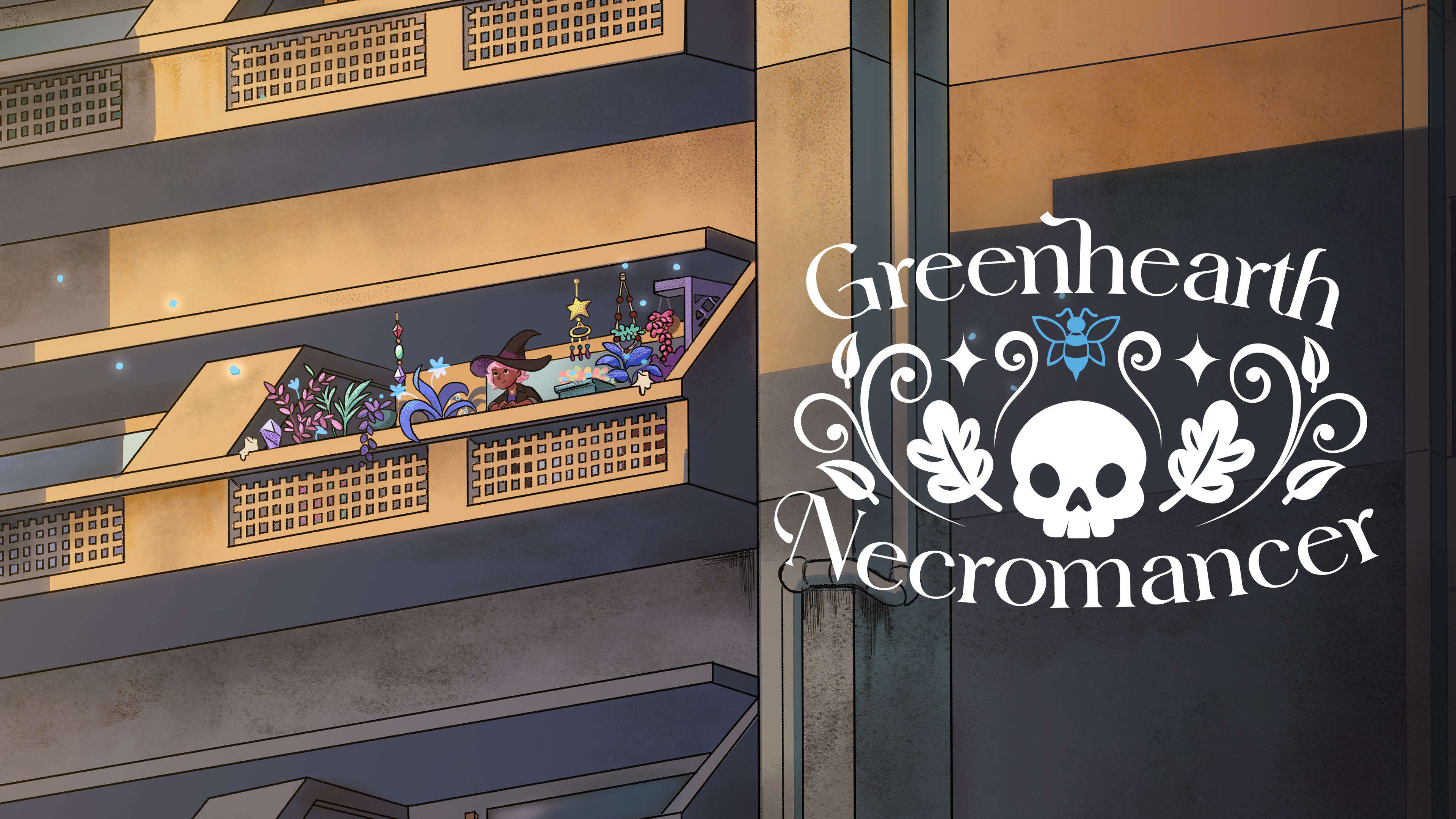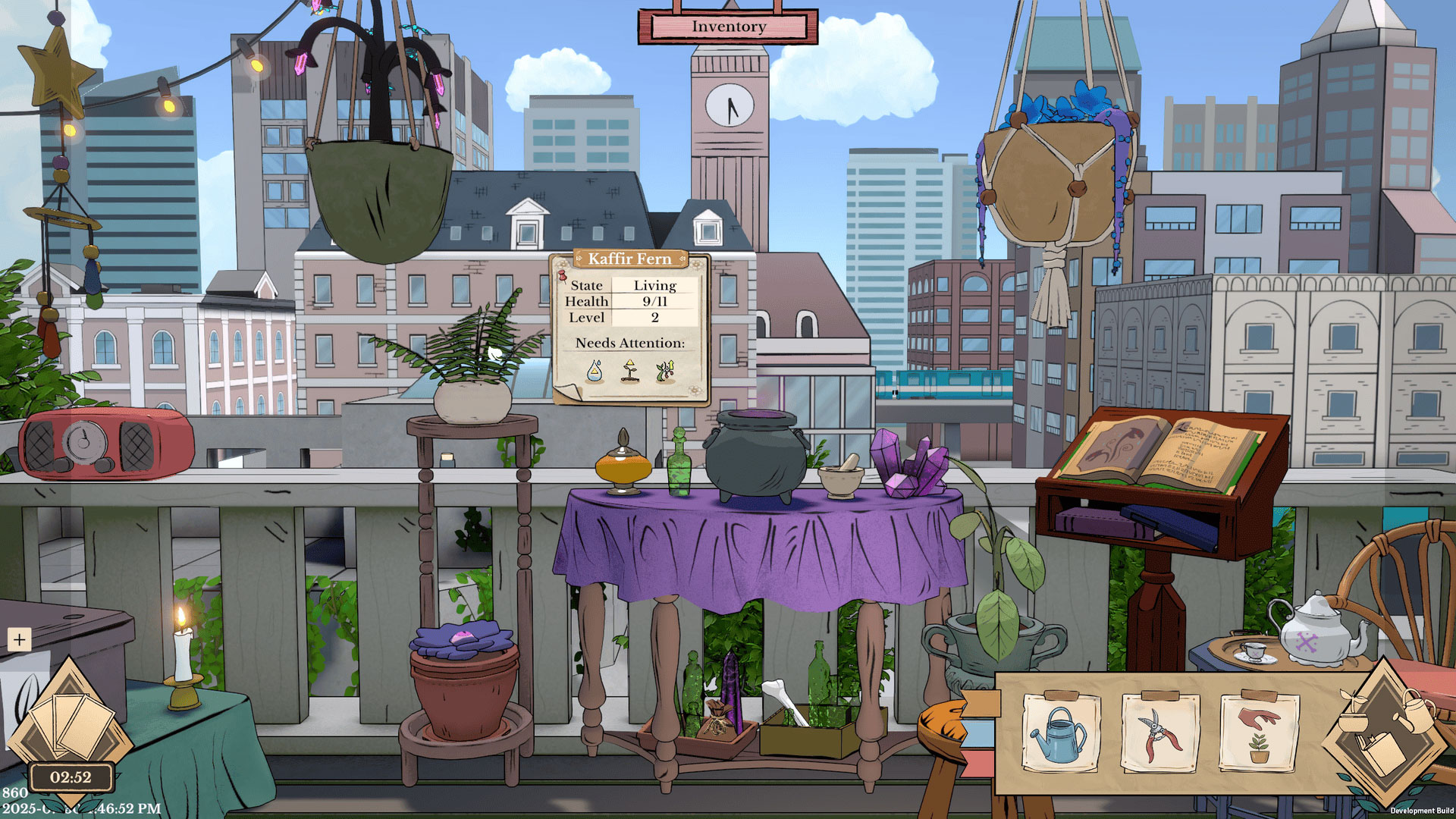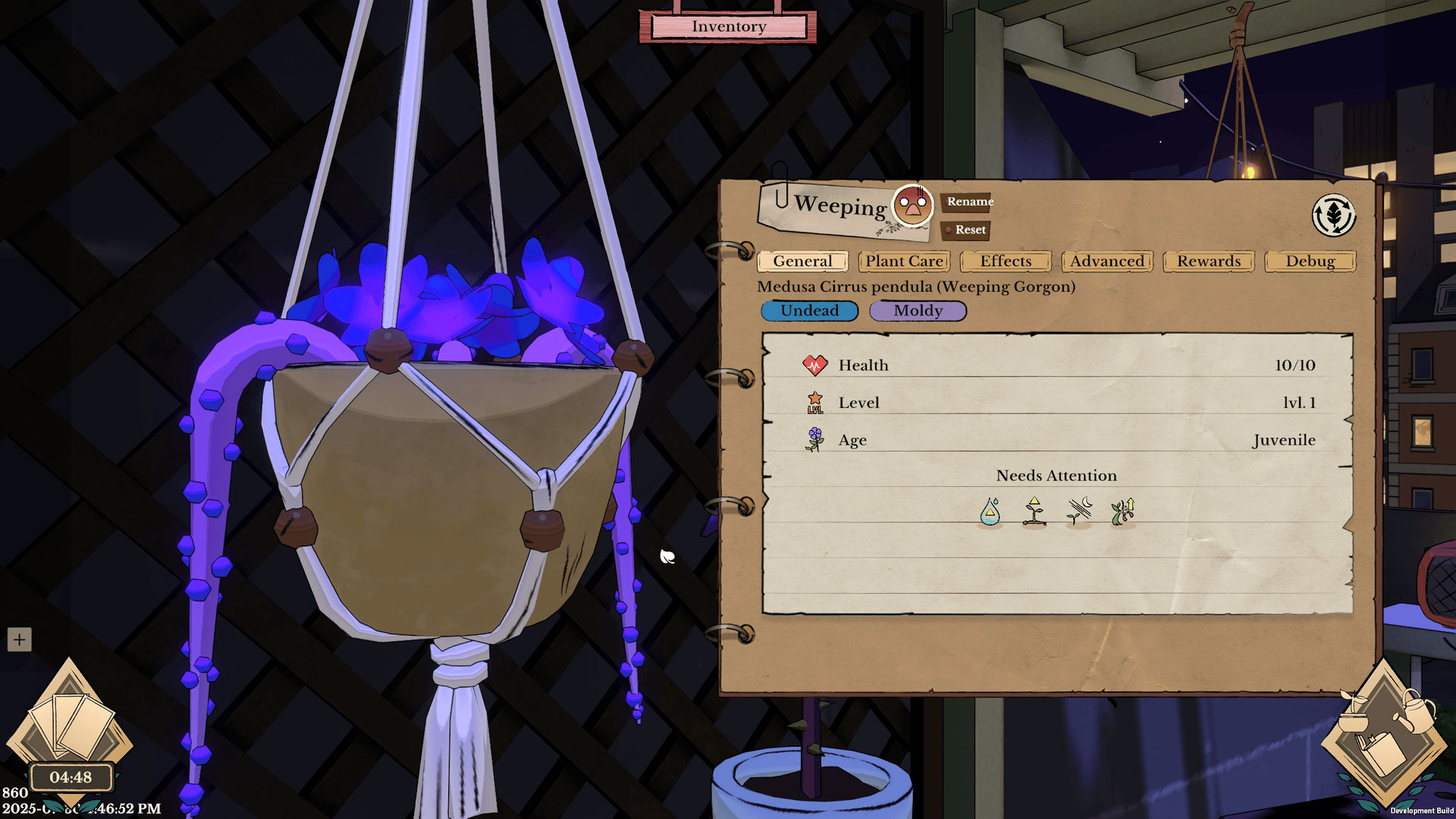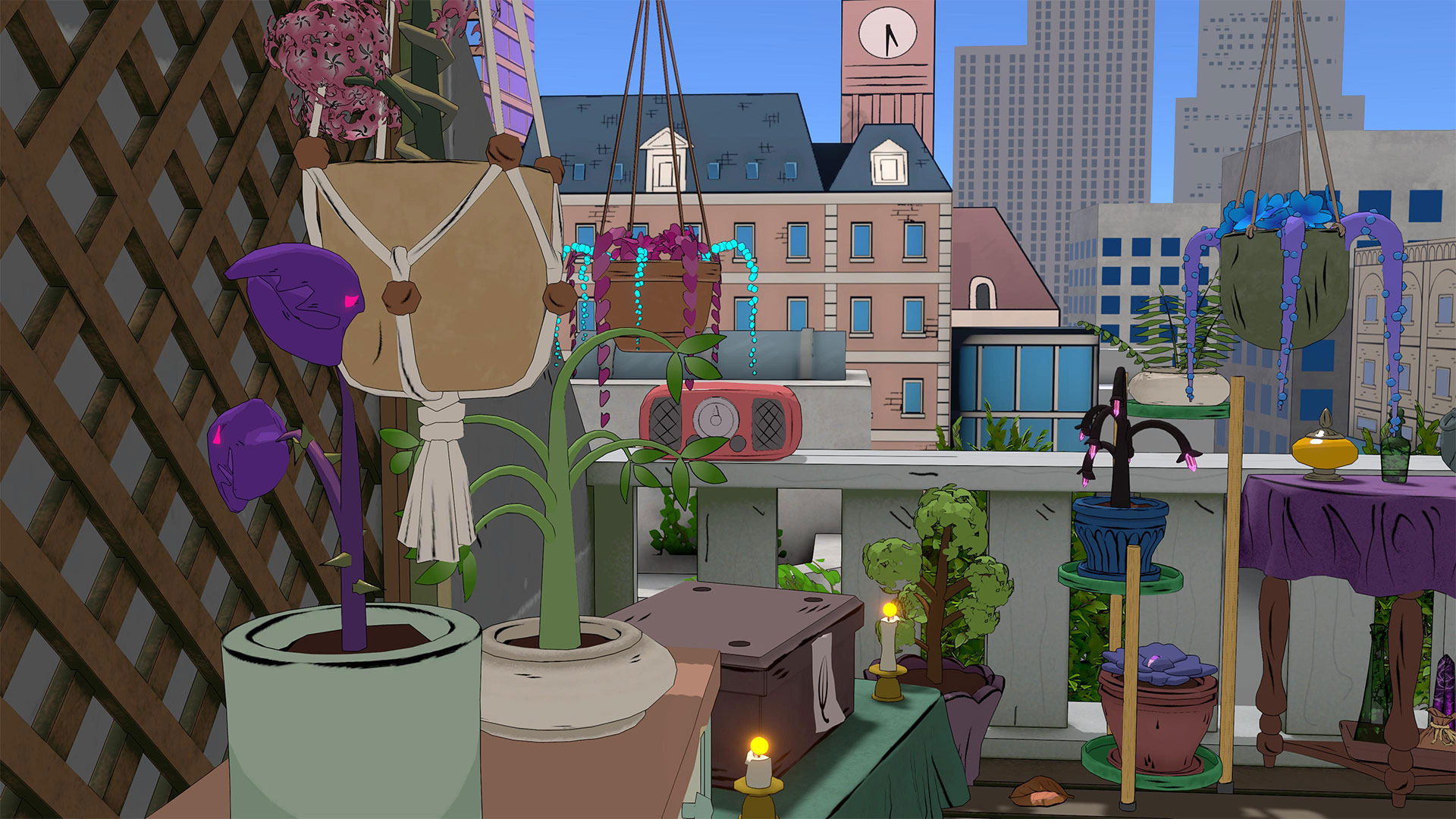
Greenhearth Necromancer is a cozy, witchy semi‑idle garden sim that marries gentle daily rituals with a tender necromantic twist. The Early Preview drops you into the Greenhearth Co‑op to restore your late grandmother’s balcony garden alongside her mischievous familiar, Compostifer. It’s a warm, low‑pressure introduction that clearly demonstrates the core loop; resurrect, nurture, harvest; while showcasing the game’s characterful cast, handcrafted plants, and the quiet emotional core that reframes loss as care and new beginnings.
What the demo lets you do
• Resurrect and tend plants: Bring dead pots back to life (or unlife) and cultivate them into distinct companions; each species and state has unique yields, personality Quirks, growth rhythms, and care windows that reward curiosity and experimentation.
• Cast approachable spells: Use intuitive necromantic rituals to revive withered stems, speed germination, repel pests, or permanently mutagenize traits; spells feel tactile and consequential without becoming opaque.
• Build a balcony oasis: Curate plants, pots, furniture, and four radio stations to create a specific vibe; study, chill, lo‑fi, or energize; while placement, microclimates, and décor alter growth outcomes and passive synergies.
• Meet the neighbourhood: Encounter co‑op neighbours through short, choice‑driven storylets that reveal personality, small quests, and community threads; interactions seed longer narrative arcs and meaningful, low‑stakes bonds.
• Continue in idle mode: Finish the preview loop and keep tending in the background: your garden continues to grow, resources accrue, and gentle audio cues nudge you back when something needs attention, ideal for play-as-you-live rhythms.

Why the demo matters
• A precise tonal blend: The demo threads cozy routine with a soft, melancholic undercurrent; necromancy reads as caregiving rather than horror, so plant death becomes an invitation to experiment, ritualize, and start again with tenderness.
• Play your way: Greenhearth Necromancer comfortably supports both hands‑on micro‑play and relaxed semi‑idle sessions: obsess over layout, potion recipes, and timing when you want, or set up a resilient engine and let the balcony hum while you do other things.
• Meaningful simulation depth: Underneath the calm sits a believable care sim: light exposure, humidity, watering cadence, fertilizer, pest risk, and species quirks all interact to shape growth and yield; giving players who enjoy systems real payoff while remaining accessible to casual players.
• Compact, emotionally smart storytelling: Introductory beats; Echo, Compostifer, and neighbours like Demeter; deliver small, resonant moments that seed longer arcs about grief, community, and belonging without interrupting the game’s gentle flow.

Standout features showcased
• Living and undead plant variants: Undead plants develop distinct Quirks, yields, and personalities that encourage curiosity and attachment; transforming a sad, sun‑browned sprout into a spectral bloom often unlocks unique resources and surprising synergies.
• Semi‑idle progression loop: Design a self‑sustaining balcony engine of plants, potions, and passive combos, then step away: the game continues to gather resources and progress for you without punitive timers, so returns feel rewarding instead of punitive.
• Four curated radio stations: Choose from lo‑fi, ambient, upbeat drum & bass, or study‑friendly playlists to instantly shift mood and pacing; music becomes a soft gameplay lever that shapes how your sessions feel.
• Tactile, approachable magic: Spells and potions are designed to land quickly and feel satisfying; rituals that revive or mutate plants have immediate, visible effects, letting players enjoy meaningful outcomes without deep UI complexity.

Narrative design as system work
• Story woven into systems, not shoehorned into cutscenes: Narrative beats are delivered through mechanics and choices: storylets unlock as you tend specific plants, neighbour interactions trigger from journal entries or market goods, and Grandma’s research appears as discoverable upgrades rather than a single exposition dump.
• Player actions drive meaning: Plant care, resurrection rituals, and potion recipes double as storytelling tools; the way you resurrect a plant or whether you brew a restorative potion shapes how characters react and what narrative threads open.
• Bite‑sized delivery for semi‑idle pacing: Beats are intentionally short and modular so they fit into casual check‑ins; each narrative nugget is satisfying on its own but also stacks into longer arcs for players who stick around.
• Rewarding exploration and emergent story: Journals, environmental details, and optional neighbour quests reward curiosity; small discoveries recontextualize grief, community, and Echo’s growth without forcing linear progression.
• Feedback loops that teach story through play: Narrative cues are integrated into UI and systems (dialogue seeds in tooltips, plant Quirks that hint at past events), letting players learn the world’s history by doing rather than reading long texts.

Echo Compostifer and community first
• Characters grounded in everyday truth: The cast is drawn from recognizable, lovable archetypes; Echo’s anxious‑but‑resilient coming‑of‑age arc, Compostifer’s sardonic and helpful familiar energy, and neighbours like Demeter who bring warmth, routine, and small rituals to the co‑op.
• Relationships grow from play, not exposition: Bonds form through garden tasks, exchanged goods, and short, choice‑driven quests rather than long cutscenes; helping a neighbour with a pest problem or gifting a resurrected bloom naturally unlocks personal beats.
• Personality shown through systems: NPCs react to your gardening style and choices; gifting an undead plant to a neighbour prompts different dialogue and favors than selling its produce, making friendships mechanically meaningful.
• Small moments, big payoffs: Micro‑interactions; a coffee‑break chat, a shared market stall, a journal note from Grandma; accumulate into emotional arcs that feel earned and intimate.
• Community as gameplay loop: The co‑op isn’t just backdrop; it’s a living feedback network where reputation, favors, and neighbour requests feed into progression, storylets, and new plant recipes.

Paper prototyping and play‑by‑feel iteration
• Tabletop first, code later: Systems were sketched and stress‑tested with paper prototypes and Miro playtests to surface edge cases and emergent combos before a single line of code was written.
• Fast failure, fast learning: Running physical playtests let designers iterate rules, costs, and timings quickly: broken ideas were discarded in an afternoon, good ones scaled into digital prototypes.
• Focus areas validated early: Placement choices, action economies (how many meaningful interactions per session), and inter‑plant synergies were tuned at the tabletop stage so digital builds arrived with clearer intent.
• Mixed playtest methods: Sessions ranged from internal designer games to blind tests with outside players, giving both informed and fresh perspectives that highlighted confusing UX and surprising emergent strategies.
• Outcomes - depth without friction: The iterative process produced systems that reward optimization but remain approachable: clearer affordances, fewer needless micromanagement traps, and satisfying passive engines for semi‑idle play.

Semi‑idle design philosophy
• Play on your terms: The game deliberately supports multiple engagement levels; you can architect elaborate plant‑and‑potion engines or set a resilient setup and let the balcony hum in the background.
• Meaningful outcomes for both styles: Balance prioritizes reward parity so active tinkering and passive play both produce satisfying progression and discovery.
• No punitive clocks: Timers are designed to be gentle; missed check‑ins slow momentum but never punish players with irreversible failure, keeping the experience cosy and low‑pressure.
• Transparent, teachable systems: Clear feedback; visual states, concise tooltips, and contextual UI; helps players learn why things succeed or fail, whether they’re optimizing or idly checking in.
• Audio that fits life, not interrupts it: Selective sound cues and configurable notifications let the game nudge you when necessary without breaking concentration during work or study.
• Designer tradeoffs for fairness: Tuning focused on reducing grind and preventing dominant overnight exploits, so long‑term engines scale reasonably and social/market loops remain engaging.

Audio and mood as soft gameplay levers
• Music as companion, not distraction: Tracks are composed to live in the background: they set tone and pacing without demanding attention, so players can work, study, or relax while the balcony breathes.
• Four radio stations as a gameplay dial: Swap between lo‑fi, ambient, drum & bass, and study playlists to instantly change session tempo and emotional colour, influencing how you play without altering core mechanics.
• Layered, responsive sound design: Ambient garden ambiences, plant-level audio cues, and UI hits are mixed to react to game state: a thirsty plant gives a subtle chime, a successful resurrection blooms with a warm flourish.
• Diegetic audio that teaches: Many cues are grounded in the world; birdcalls, distant market bustle, and Compostifer’s grumbles communicate status and story information through sound alone.
• Configurable interruptions for real life: Selective audio push settings let players choose which alerts break through when the game is inactive, keeping gameplay companionable rather than intrusive.
• Varied procedural touches: Small, randomized audio variations; pollen motes, pot clinks, critter squeaks; prevent repetition and make repeated check‑ins feel fresh.
• Accessibility and mixing controls: Independent sliders for music, ambience, and effect layers let players tailor the soundscape for focus, comfort, or sensory needs.
• Audio as emotional punctuation: Short, characterful sounds (the composter gurgle, a neighbour’s laugh) add charm and help moments land emotionally without needing extra text or cutscenes.

Art direction rooted in tactile charm
• Brutalist meets botanica: The game pairs concrete, blocky apartment silhouettes with lovingly detailed, hand‑drawn plant art so the world feels grounded and unexpectedly warm; the contrast highlights the garden as a place of refuge.
• Readable at a glance: Leaf shapes, silhouette language, and contrast were designed for instant legibility: you can tell species, growth stage, and living vs undead state from a quick pass, which keeps semi‑idle play smooth and intuitive.
• Distinct living / undead visual grammar: Living plants favour saturated, warm palettes and soft motion; undead variants use cooler highlights, subtle spectral glows, and altered geometry (tattered leaves, curling veins) so “unlife” reads as thriving, not grotesque.
• Tactile material cues: Surface treatments (matte pots, flaking paint, mossy soil, faint bioluminescent veins) sell the physicality of the balcony and make interactions; prune, water, compost; feel tangible even in a stylized space.
• Micro animation for personality: Small, looping animations (a leaf twitch, pollen motes, a plant sigh) give Quirks and maturity visual weight, helping players form emotional bonds without interrupting idle flow.
• Decor and props as storytelling tools: Pots, radio sets, journals, and knickknacks communicate character and history; environmental details echo Grandma’s research and the co‑op’s lived‑in warmth.
• Palette and lighting do narrative work: Time‑of‑day lighting and curated palettes shift emotional tone (cozy gold at dusk, cool blue at night), reinforcing mood without changing mechanics.
• Accessible by design: High‑contrast variants, iconographic overlays, and clear color cues ensure important states are visible to players with differing visual needs.
• Scalable for marketing and UI: Art choices translate cleanly from tiny UI icons to hero banners and animated GIFs, helping the game’s visual identity stay strong across store pages and social posts.

Who will enjoy the demo
• Cozy‑sim fans who like gentle systems, personalization, and slow narrative beats.
• Players who appreciate hybrid idle games that reward both fiddly optimization and relaxed play.
• Anyone drawn to warm, hand‑crafted art, music that complements background play, and character‑first storytelling about everyday community life.

Final impression
The Early Preview is a warm, artful invitation into Greenhearth Necromancer’s world. It nails the core promise; cultivating a balcony where life and unlife coexist; with a tone that’s equal parts cozy and gently funny, and it pairs that voice with tangible systems: plant variants that charmed me, approachable necromantic spells, and a semi‑idle loop that respects your time. Narrative threads and character moments hint at deeper emotional layers without slowing the flow, and the demo leaves you curious about mechanics and relationships the full game will expand. For anyone who enjoys low‑pressure sims with room for experimentation and heart, this is a delightful first step into a small, magical community.
Watch and Wishlist
• Wishlist on Steam: Add Greenhearth Necromancer to your wishlist to get notified when the public demo, builds, or launch discounts go live and to help the game reach more players.
• Follow Silverstring Media: Track development on Bluesky, TikTok, Instagram, and Twitch for bite‑size devlogs, concept art, WIP GIFs, and behind‑the‑scenes clips that show systems in action.
• Subscribe to the newsletter: Get direct updates in your inbox: demo windows, devlog summaries, zine/PDF drops from events, and exclusive community notes you might not see on socials.
• Attend streams and events: Join live demos, Q&As, and playtests to see design decisions explained in real time, ask about mechanics like necromancy, potion crafting, and Quirks, and influence future tuning.
• Engage with the community: Follow Discord threads and comment on dev posts to share feedback, report any assets we missed updating, and participate in polls or early access initiatives.
• Watch for demo and bundle timing: If you prefer a more polished experience or discounts, keep an eye on seasonal sales and bundle offers that may pair the demo or full release with soundtracks or art packs.
Key Takeaways
• Tone and concept: Greenhearth Necromancer blends cozy gardening with a gentle necromantic twist, reframing death as care and experimentation rather than horror.
• Accessible semi‑idle design: The game supports both hands‑on micro‑play and relaxed background progression, letting players engage at their preferred pace.
• Living vs undead plants: Transformations matter; undead variants gain Quirks, unique yields, and personality, encouraging experimentation and emotional attachment.
• Meaningful systems under the surface: A believable plant sim (light, humidity, watering cadence, fertilizer, pest risk, species quirks) rewards players who dive deeper while staying approachable for casual play.
• Tactile magic and potions: Spells feel immediate and satisfying, offering clear, consequential effects without heavy UI complexity or opaque minigames.
• Character and community hooks: Introductory narrative moments; Echo, Compostifer, and neighbours; seed longer arcs about grief, belonging, and small‑town ties.
• Strong audiovisual vibe: Handcrafted art, multiple radio stations, and a warm soundtrack create a cozy ambience suited to study, chill, or focused sessions.
• Demo as an invitation: The Early Preview is a polished first step that showcases core loops, systems, and tone while leaving room for the full game’s deeper narrative and mechanical expansion.
Game Information:
Developer: Silverstring Media Inc.
Publisher: indie.io
Platforms: PC (reviewed)
Release Date: Coming Soon
Score: 10 / 10
Greenhearth Necromancer earns a perfect score for delivering a rare blend of warmth, systems, and soul; a cozy sim that actually respects your time and emotions. Everything clicks: a soft, clever premise (necromancy as care), a semi‑idle loop that rewards both tinkering and gentle background play, and plant systems with surprising depth that invite experimentation without punishing curiosity. The cast and writing lend real heart to small moments, while the art, sound, and UI work together to make every interaction feel tactile and satisfying. Whether you want a calming companion running while you study or a niche playground for optimization and discovery, Greenhearth Necromancer feels complete, generous, and lovingly crafted; a ten out of ten for design, tone, and sheer charm.